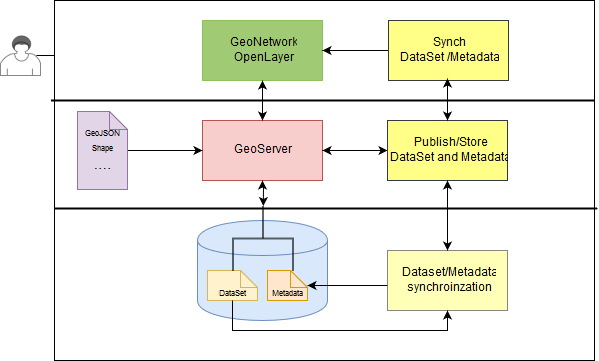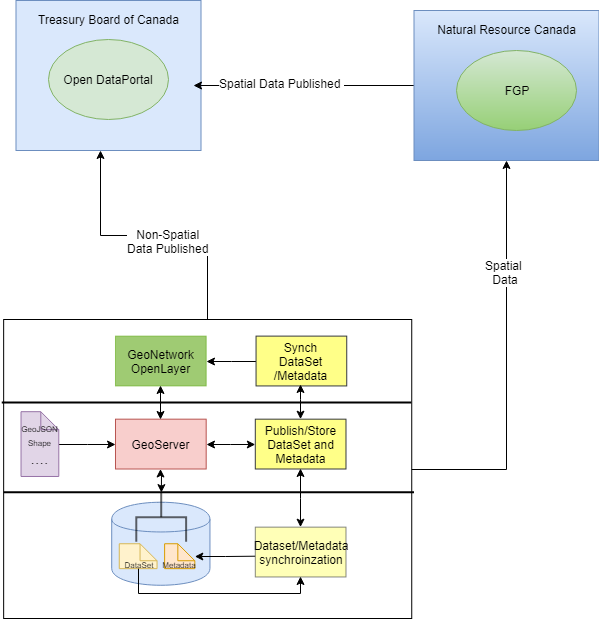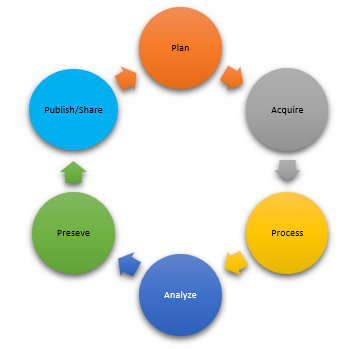Important: The GCConnex decommission will not affect GCCollab or GCWiki. Thank you and happy collaborating!
Difference between revisions of "Data Catalog"
| Line 24: | Line 24: | ||
== Data Catalog Architecture == | == Data Catalog Architecture == | ||
'''A work in progress Architecture''' | '''A work in progress Architecture''' | ||
| + | |||
| + | 1- How the Catalog will be connected to TADAP | ||
| + | |||
| + | file:Catalog_TADAP.png | ||
| − | How data is published to FGP and Open Data Portal | + | 2- How data is published to FGP and Open Data Portal |
{| class="wikitable" | {| class="wikitable" | ||
|- | |- | ||
Revision as of 14:15, 1 October 2018
Data Catalog
Data catalog is an organized service that allows users to centralize Metadata and learn more about their data sources which help organizations achieve more values from their assets.
Following are some advantages to centralizing Metadata:
- Consistency and accuracy across the department/government
- Better data congruency, quality and structure
- Makes data easily accessible
- Allow users to self-serve
Why Data Catalog
In an enterprise vision, we would like to minimize the number of data silos, get a faster access to what matters most, and function as a single source (during the Data Life Cycle) for better doing.
Data-driven culture empowers users with getting access to their data source. With this, the growing numbers of cloud applications, privacy regulations and security rules are making it more difficult to effectively secure and govern data
Therefor, a Data Catalog is needed to:
- Spend less time searching for data and more time using it to gain insight
- Have a better/safer access to data through governance. Departments have a hard time finding data and controlling who has access to it.
- Reduce the cost of data redundancy and hoarding.
- Better linkage between the technical value of Metadata and the business value.
Data Catalog Architecture
A work in progress Architecture
1- How the Catalog will be connected to TADAP
file:Catalog_TADAP.png
2- How data is published to FGP and Open Data Portal
| Catalog Conceptual Architecure | How data is published to FGP and Open Data Portal |
|---|---|
 |

|
List of Stakeholders
Please note this is an initial list.
Please feel free to contact us if you think there's room for improvements.
| Sector | Contact Person | Project / Program |
| Conservation and Protection | Lise Melanson | Department Violation System (DVS) |
| Pauline Lalonde | C-STAT | |
| Canada Coast Guard | Shawn Legault and Nicholas O’Hara | SIPA |
| Jean-François Coutu | INNAV | |
| Chris Burnie-Gardiner and Patrick Marion | SISAR | |
| Bert Paulin | Reporting for CCG programs | |
| Canadian Hydrographic Services | Terry Fanning and Matthew McGowan | Main work is to move science, ocean, and species data to the Government of Canada Open Portal |
| Claude Guay | Metadata management and data management for whole science sector | |
| SRS, Science Branch | Theraesa Coyle and Johannie Duhaime | Aquaculture Monitoring Program |
| Fishery & Assessment Data Section, Science Branch | Bruce A. Patten and Di Wan | Scientific survey documentation for fish population assessment, fish harvest tracking and reporting |
| Aquaculture Management Directorate, Aquatic Ecosystems Sector | Tyree Lush and Arsenault Shane | Canadian Shellfish Sanitation Program (CSSP) mapping system |
| Fisheries & Licence Policy / Fisheries and Harbour Management | Mark Ledwell | FHM |
| Ecosystems and Fisheries Management: System Integration | Aaron Gillis and Andrew Frost | EFM-SI |
| Information Management and Policy Strategies | Lyn Warner | Open Data Portal |
| Ocean Data and Information Section | Tobias Spears | To be determined |
Data Catalog Team
please feel free to contact us to discuss the project and how you can participate
| Name | |
| George Esper | |
| Riham Elhabyan | |
| David Cornwell | |
| Yask Shelat | |
| Abdul K Hamdo |

